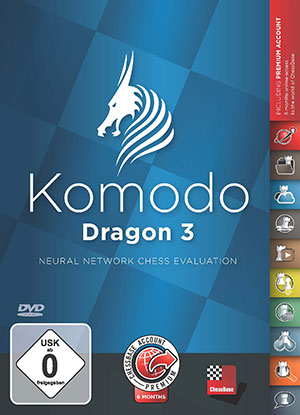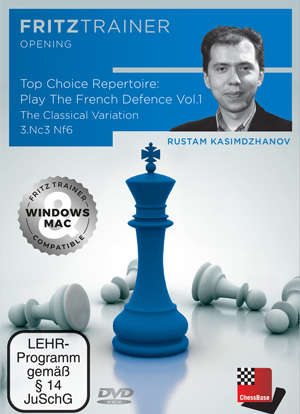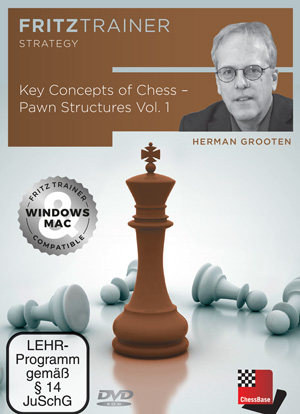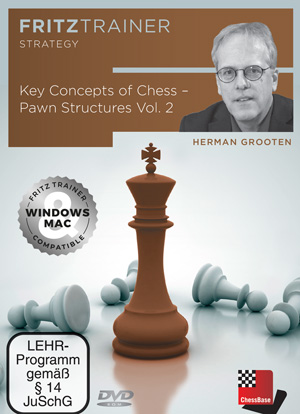CHESSBOOK REVIEWS

Latest book
reviews of 1 July 2022
Wilhelminalaan 33
7261 BP RUURLO
The Netherlands.
John
Elburg

ChessBase Magazine issue 207
Extra
June 2022
ChessBase
http://www.chessbase.com
E-Mail
info@chessbase.com
ISSN 1432-8992
Euro 12,99
System requirements:
Minimum: Pentium III 1 GHz, 1 GB RAM, Windows Vista, XP
(Service Pack 3), DirectX9 graphic card with 256 MB RAM, DVD-ROM drive,
Windows Media Player 9, ChessBase 12/Fritz 13 or included Reader and
internet connection for program activation. Recommended: PC Intel Core
i7, 2.8 GHz, 4 GB RAM, Windows 8.1 or Windows 10, DirectX10 graphic
card (or compatible) with 512 MB RAM or better, 10
The main file on this well made ChessBase Magazine is good for 48462
latest played games!
Even more interesting is the Lucky Bag file with 58 heavy loaded
annotated games!
A fine example of play is: Bodnaruk,Anastasia (2465) - Abasov,Nijat
Azad (2552) [B33]
Baku op Baku (4), 21.09.2016
[Abasov, Nijat]
1.e4 c5 2.Nc3 Nc6 3.Nge2 During the game I spent I spent some minutes
to understand the reason, why she opted this move order. Honestly
speaking, I couldn't understand a point as I wouldn't play anything
beside Sveshnikov! 3...Nf6 4.d4 cxd4 5.Nxd4 e5 6.Ndb5 d6 7.Bg5 a6 8.Na3
b5 9.Nd5 Be7 10.Bxf6 Bxf6 Sveshnikov used to be my main repertoire
since I learned chess until I became GM in 2010. The reason I stopped
playing Sveshnikov actually was the 11.c4 variation. I would always
fail to come up with the right plan and often find myself in trouble.
My hate towards the given system would get bigger by each game. In 2015
I decided to check what actually is going on in Sveshnikov and to my
surprise I realized the theory has been changed a lot ever since my
last game in it! Thus, I decided to update my old notes and begin
playing it again! 11...b4 12.Nc2 0-0 13.h4 The third choice by White,
however, it transposes to 13.g3 later on [The other two moves of White
are 13.Be2 ;
and 13.g3 a5 (13...Bg5 14.Bg2 Qa5 was the system I used to play a lot
in 2010.) 14.h4 Be6 what transposes to the actual game] 13...Be6
[13...a5 is fine too.] 14.g3 [on 14.Qf3 I was planning to do 14...Be7"
(14...Bxd5?! 15.cxd5 Nd4 16.Nxd4 exd4 17.Bd3 followed by g3 and short
castle looks good for White) ] 14...a5 15.Bh3 a4 While preparing to the
game, I noticed Anastasia had two games in this variation and I paid
close attention to what to do exactly in this kind of positions the
most 16.Kf1!? now she opted the main move [First time she tried 16.Bxe6
fxe6 17.Ndxb4 Nxb4 18.Nxb4 Qb6 19.Qd2 Be7! 20.0-0 1/2-1/2 (32)
Bodnaruk,A (2382)-Ushenina,A (2486) Sochi 2015 (20.a3 Rf3 and White's
unable to castle kingside due to ...-Rxg3) and here I was going to
improve Black's play with 20...d5! 21.Nd3 dxe4 22.Nxe5 Rf5µ;
in her second game, she played 16.b3 and my idea was to play 16...Nd4!?
17.Nxd4 (17.Ndxb4 Bxh3 18.Rxh3 axb3 19.Nxd4 b2 20.Rb1 exd4µ)
17...exd4 18.Rc1 Bxd5 19.cxd5 axb3 20.axb3 Re8 21.Bg2 d3!? and Black
looked good] 16...b3 17.Nce3 [17.axb3 axb3 18.Rxa8 Qxa8 19.Nce3 Nd4
20.Kg2 Bd8= with mutual chances] 17...Rb8 18.Kg2 [18.axb3!? Rxb3
19.Rxa4 Rxb2 20.Kg2 Nd4 21.Qa1 Qb8 22.Ra2 Rxa2 23.Qxa2 Bd8 24.Rb1 Qc8
25.Nf5 Qc5"] 18...Nd4 19.a3?! Till here it all was my home preparation
and I even remembered 19...-g6 to be in my file [19.axb3 should have
been played, after what position leads to 19...Rxb3 20.Rxa4 Rxb2 the
aforementioned line] but somehow, over the board 19...Rc8!? followed by
...-Rc5 seemed much better to me 20.Rc1N Rc5 I was happy with the
outcome of the opening duel. I had more time and reach of play
position. Couldn't ask for better. 21.Qd2 Qa8 my idea was to bring the
Queen to c6. [21...g6 was better according to engine.] 22.Nxf6+ gxf6
23.f3 defends the e4-pawn. [23.Nd5?! Kg7 24.h5 h6µ I stabilize
the position of my King and next prepare ...-f5] 23...Qc6 [23...h5
followed by ...-Kg7 would kill any kind counterplay of White on the
kingside.] 24.Rc3 Kh8!? smart King maneuver [the immediate 24...Kg7 was
bad due to 25.Bxe6 fxe6 26.Ng4 and I cannot stop Qh6 with the next
move.] 25.Nd5 [25.Rd3 with the idea of sacrificing the exchange on d4
would be strong if only not 25...Bxh3+ (25...Bxc4? 26.Rxd4! exd4
27.Qxd4 d5 28.Rc1!±) 26.Rxh3 f5! 27.Rxd4 exd4 28.Qxd4+ f6
29.exf5 Re5! 30.Rh1 Qc5! 31.Qxc5 dxc5 32.Kf2 Rfe8 33.Re1 h5! 34.Re2
Kg7µ and Black should be capable of winning this endgame] once
the Knight is gone away from the g4-square I can play 25...Kg7! 26.Rhc1
Qc8 27.g4 now White threatens to take on f6. 27...h6 [in case of
27...Bxd5 28.cxd5 Rxc3 29.Rxc3 Qa6 30.g5 is what I was afraid of] 28.f4
White plays aggressive! 28...Bxd5 29.cxd5? This naturally looking move
in fact is a very serious positional mistake. Now I'm much better!
[29.exd5 should have been played instead and after for instance
29...Rg8 30.g5 Qd8 31.gxf6+ Qxf6 32.fxe5 position becomes extremely
complicated! Although, the engines are totally cool about anything and
calmly shows triple zeros, basically in any line. For example:
32...Qxh4 33.Rg3+ (33.exd6 Nf5!?) 33...Kh8 34.Rxg8+ Kxg8 35.exd6 Qe4+
36.Kg3T Ne2+ 37.Kh2 Qe5+ 38.Kh1 Qe4+ 39.Kh2 with numerous only moves
for each side the game ends in a draw, obviously...] 29...Rxc3 30.Rxc3
Qa6 [30...Qd8!? was better according to engine, however, with the text
move my idea was to have the opportunity of playing ...-Qe2] 31.Kf2?!
[31.fxe5! was the best practical chance for White 31...fxe5 (31...dxe5)
32.g5 Qe2+ (32...h5 33.Kh2f) 33.Qxe2 Nxe2 34.gxh6+ Kxh6 35.Rc6 Nf4+
36.Kg3! (36.Kh2? Kh5! and suddenly Black gets active with the King!
37.Rxd6 Kxh4 38.Bf5 Kg5-+ followed by ...-Nd3, Black is winning)
36...Rg8+ 37.Bg4! Ne2+ 38.Kh3 Nf4+ 39.Kg3 and Black has nothing more
than the repetition.] 31...Rc8 now I manage to trade off the Rooks,
after what my King starts feeling himself safer, whilst White King
becomes more vulnerable. Also, the superiority of my Knight on -d4
becomes more obvious. 32.Bf1 [in case of 32.Rxc8 Qxc8 33.fxe5 I should
be careful what to recapture with on e5! as 33...fxe5 leads to a draw
only (33...dxe5! 34.Qxh6+ Kg8! 35.Qxf6 Qc2+ and Black shall win.) after
34.Qxh6+! Kxh6 35.g5+ Kh5 36.Bxc8 Kxh4 37.Bd7 Kxg5 38.Ke3 and now I
have to be precise for not getting into a serious trouble! (38.Bxa4?
Kf4-+) 38...Nc2+ 39.Kd3 Kf4 40.Bxa4 Nd4 followed by ...-f5 should
maintain the equality. 41.Bd7 f5 42.exf5 Nxf5 43.Bxf5 Kxf5 44.a4 e4+
45.Ke3 Ke5 46.a5 Kxd5 47.a6 Kc6 48.Kxe4 Kb6 49.Kd5 Kxa6 50.Kxd6 and
with the help of 'opposition' Black is drawing the pawn endgame.]
32...Qa5! 33.g5 fxg5 [33...hxg5 34.hxg5 f5 was slightly more accurate
35.exf5 Nxf5-+] 34.hxg5 h5! creating outside passed in the endgame.
35.f5 Rxc3 36.bxc3 Nc2 37.Bd3 Qc5+ 38.Kf3 [38.Kf1 Ne3+ 39.Ke2 Ng4-+]
38...Qg1 39.Bxc2 Qf1+ 40.Ke3 Qf4+ 41.Kd3 Qxd2+ 42.Kxd2 bxc2 and thanks
to the organized outside passed pawn on move 34, I win the game now.
43.c4 h4 44.c5 h3 and White resigned. 0-1
Jorden van Foreest contributes "The brilliancy" of this edition. At the
Tata Steel Masters 2022, the young chess genius played an
interesting opening experiment against Praggnanandhaa: 1.e4 c5 2.Nf3
Nc6 3.Bc4 e6 4.0-0 d5 5.Bb5! dxe4 6.Ne5 Qc7 7.Nxc6 bxc6 8.Bc4!
Includes as always the smashing video files as from Ivan
Sokolov,Budapest Gambit, Elisabeth Pähtz: Gruenfeld Defence
Fianchetto Variation with 10.h3 and the Brilliancy!
Conclusion: Smashing material for a
bargain price!

Komodo Dragon 3
ChessBase
http://www.chessbase.com
E-Mail
info@chessbase.com
Price €99,90
SYSTEM
REQUIREMENTS: Minimum: PPC Core i3 or i5 / AMD FX or Ryzen 3, 2 GB RAM,
Windows 8/8.1 64Bit, DirectX9, graphics card with 256 MB RAM, DVD-ROM
drive, Windows Media Player 11 and Internet access. Recommended: PC
Core i7, i9 or AMD FX, Ryzen 7/9 and Windows 10 or 11 (64-Bit), 4 GB
RAM, DirectX10, graphics card with 512 MB RAM or more, Windows Media
Player 11, DVD ROM drive and Internet access.
For ChessBase ACCOUNT: Internet access and latest browser, e.g. Chrome,
Safari. Runs on Windows, OS X
The new
Komodo Dragon 3 engine has been improved by 100 Elo points in playing
strength over its predecessor.
Unbelievable for a engine that already reached an Elo level of
over 3500 points!
After ChessBase the gain is even greater (120 to 130 Elo points) for
unbalanced openings, e.g. rare variations or gambits. On multiple cores
or longer time controls the Elo gain can be somewhat smaller, due to
the higher draw range.
Komodo Dragon 3 takes only about a quarter of the time to play or
analyze at the same level as Dragon 2! Or it plays better chess in the
same time on a single core than its predecessor did on four cores. The
large Elo increase is due to a new net structure for NNUE with a
corresponding new net, as well as various optimisations and
improvements in the search.
The previous playing level scheme model has been replaced in Komodo
Dragon 3 with arbitrarily adjustable Elo strength settings from 1 to a
maximum of 3500. The Elo values refer to human play in rapid chess and
are can be used to ensure balanced games. With reduced playing strength
the engine makes the kind of mistakes that are to be expected from
humans with rating level that is set. The Elo settings of Komodo Dragon
3 have been tested and tuned against many human players, of various
playing strengths. It was optimized in the GM level in many rapid chess
games against GM Alex Lenderman, who is part of the Komodo development
team.
Also included in Komodo Dragon 3:
The current Fritz 18 user interface
6 months premium membership for playchess.com / ChessBase Account
Conclusion: Impressive and unbeatable!

Top Choice Repertoire:
Play the French Defence Vol.1
by Rustam Kasimdzhanov
http://www.chessbase.com
E-Mail
info@chessbase.com
2022
Price Euro 29.90
Windows 7 or higher
Minimum: Dual Core, 2 GB RAM, DirectX11, graphics card with 256 MB RAM,
DVD-ROM drive, Windows Media Player 9, ChessBase 14/Fritz 16 or
included Reader and internet access for program activation.
Recommended: PC Intel i5 (Quadcore), 4 GB RAM, Windows 10, DirectX11,
graphics card with 512 MB RAM or more, 100% DirectX10-compatible sound
card, Windows Media Player 11, DVD-ROM drive and internet access for
program activation.
MacOSX only available as download! Minimum: MacOS "Yosemite" 10.10

Top Choice
Repertoire: Play the French Defence Vol.2
by Rustam Kasimdzhanov
http://www.chessbase.com
E-Mail
info@chessbase.com
2022
Price Euro 29.90
Windows 7 or higher
Minimum: Dual Core, 2 GB RAM, DirectX11, graphics card with 256 MB RAM,
DVD-ROM drive, Windows Media Player 9, ChessBase 14/Fritz 16 or
included Reader and internet access for program activation.
Recommended: PC Intel i5 (Quadcore), 4 GB RAM, Windows 10, DirectX11,
graphics card with 512 MB RAM or more, 100% DirectX10-compatible sound
card, Windows Media Player 11, DVD-ROM drive and internet access for
program activation.
MacOSX only available as download! Minimum: MacOS "Yosemite" 10.10
The great grandmaster master Rustam Kasimdzhanov provides the
user of these two chess DVD’s with a well thought life time repertoire
based on the ever popular French Defence.
The French is the perfect choice for all who like to seize the
initiative.
But first what can we find on the first DVD:
Introduction
Model Game 1: Karjakin-Morozevich
Model Game 2: Aronian-Bluebaum
Model Game 3: Movsesian-Meier
Analysis Database
1.e4 e6 2.d4 d5 3.Nc3 Nf6 4.e5
1.e4 e6 2.d4 d5 3.Nc3 Nf6
4.e5 Nfd7 5.Nce2 c5 6.c3 Nc6 without f4
4.e5 Nfd7 5.Nce2 c5 6.c3 Nc6 7.f4 Be7 8.Nf3 0-0 9.h4/g3/a3
4.e5 Nfd7 5.Nce2 c5 6.c3 Nc6 7.f4 Be7 8.Nf3 0-0 9.Be3
4.e5 Nfd7 5.Nf3
4.e5 Nfd7 5.f4 c5 6.Nf3 Nc6 7.Be3 cxd4 8.Nxd4 Qb6 Intro
4.e5 Nfd7 5.f4 c5 6.Nf3 Nc6 7.Be3 cxd4 8.Nxd4 Qb6 Sidelines
4.e5 Nfd7 5.f4 c5 6.Nf3 Nc6 7.Be3 cxd4 8.Nxd4 Qb6 9.Qd2 Qxb2 10.Rb1 Qa3
11.Ncb5 Qxa2 12.Rb3
4.e5 Nfd7 5.f4 c5 6.Nf3 Nc6 7.Be3 cxd4 8.Nxd4 Qb6 9.Qd2 Qxb2 10.Rb1 Qa3
11.Ncb5 Qxa2 12.Rd1/Rc1
4.e5 Nfd7 5.f4 c5 6.Nf3 Nc6 7.Be3 cxd4 8.Nxd4 Qb6 9.Qd2 Qxb2 10.Rb1 Qa3
11.Bb5 Nxd4 12.Bxd4 a6 early deviations
4.e5 Nfd7 5.f4 c5 6.Nf3 Nc6 7.Be3 cxd4 8.Nxd4 Qb6 9.Qd2 Qxb2 10.Rb1 Qa3
11.Bb5 Nxd4 12.Bxd4 a6 13.Bxd7 Bxd7 14.Rxb7
4.e5 Nfd7 5.f4 c5 6.Nf3 Nc6 7.Be3 cxd4 8.Nxd4 Qb6 9.Qd2 Qxb2 10.Rb1 Qa3
11.Bb5 Nxd4 12.Bxd4 a6 13.Bxd7 Bxd7 14.Rb3 Qe7 15.0-0
4.e5 Nfd7 5.f4 c5 6.Nf3 Nc6 7.Be3 cxd4 8.Nxd4 Qb6 9.Qd2 Qxb2 10.Rb1 Qa3
11.Bb5 Nxd4 12.Bxd4 a6 13.Bxd7 Bxd7 14.Rb3 Qe7 15.Rxb7 Rc8
4.e5 Nfd7 5.f4 c5 6.Nf3 Nc6 7.Be3 cxd4 8.Nxd4 Qb6 9.Qd2 Qxb2 10.Rb1 Qa3
11.Bb5 Nxd4 12.Bxd4 a6 13.Bxd7 Bxd7 14.Rb3 Qe7 15.Rxb7 Qd8
4.e5 Nfd7 5.f4 c5 6.Nf3 Nc6 7.Be3 cxd4 8.Nxd4 Qb6 9.Qd2 Qxb2 10.Rb1 Qa3
11.Bb5 Nxd4 12.Bxd4 a6 13.Bxd7 Bxd7 14.Rb3 Qe7 15.Rxb7 Qh4 16.g3/Bf2
4.e5 Nfd7 5.f4 c5 6.Nf3 Nc6 7.Be3 cxd4 8.Nxd4 Qb6 9.Qd2 Qxb2 10.Rb1 Qa3
11.Bb5 Nxd4 12.Bxd4 a6 13.Bxd7 Bxd7 14.Rb3 Qe7 15.Rxb7 Qh4 16.Qf2
1.e4 e6 2.d4 d5 3.Nc3 Nf6 4.Bg5
1.e4 e6 2.d4 d5 3.Nc3 Nf6 4.Bg5
4...h6
4...dxe4 5.Nxe4 Be7 6.Nxf6 Bxf6 7.Bxf6 Qxf6 8.Nf3 c5
4...dxe4 5.Nxe4 Be7 6.Nxf6 Bxf6 7.Bxf6 Qxf6 8.Nf3 0-0 9.Qd3 c5 and
Sidelines
4...dxe4 5.Nxe4 Be7 6.Nxf6 Bxf6 7.Bxf6 Qxf6 8.Nf3 0-0 9.Qd3 Rd8
4...dxe4 5.Nxe4 Be7 6.Bxf6 gxf6 7.g3/Qd2
4...dxe4 5.Nxe4 Be7 6.Bxf6 gxf6 7.Nc3
4...dxe4 5.Nxe4 Be7 6.Bxf6 gxf6 7.Nf3 a6 8.c4
4...dxe4 5.Nxe4 Be7 6.Bxf6 gxf6 7.Nf3 a6 8.Bd3/Qd2
4...dxe4 5.Nxe4 Be7 6.Bxf6 gxf6 7.Nf3 a6 8.Qe2 f5 9.Nc3 b5 10.Qe3/g3
4...dxe4 5.Nxe4 Be7 6.Bxf6 gxf6 7.Nf3 a6 8.Qe2 f5 9.Nc3 b5 10.0-0-0
4...dxe4 5.Nxe4 Be7 6.Bxf6 gxf6 7.Nf3 a6 8.g3 Nc6/b5
4...dxe4 5.Nxe4 Be7 6.Bxf6 gxf6 7.Nf3 a6 8.g3 f5
1.e4 e6 2.d4 d5 3.Nc3 Nf6 Sidelines
1.e4 e6 2.d4 d5 3.Nc3 Nf6
4.exd5 exd5
DVD two holds:
Introduction
Model Game 1: Kasparov-Anand
Model Game 2: Shabalov-Shirov
1.e4 e6 2.d4 d5 3.e5
1.e4 e6 2.d4 d5 3.e5 c5 4.c3 Nc6 5.Nf3 Qb6
Early sidelines
6.Na3 Bd7
6.Bd3 cxd4 7.0-0 Bd7
6.Bd3 cxd4 7.cxd4 Bd7
6.a3 Nh6 7.b4 Sidelines
6.a3 Nh6 7.b4 cxd4 8.Bxh6 gxh6 9.cxd4 Bd7 10.Ra2
6.a3 Nh6 7.b4 cxd4 8.cxd4
6.a3 Nh6 7.Bd3
6.Be2 cxd4 7.cxd4 Nh6 Sidelines
6.Be2 cxd4 7.cxd4 Nh6 8.Bxh6 Qxb2 9.Nbd2 gxh6 10.0-0 Bd7 11.Rb1 Qxa2
6.Be2 cxd4 7.cxd4 Nh6 8.Bxh6 Qxb2 9.Nbd2 gxh6 10.0-0 Bd7 11.a4/Nb3
1.e4 e6 2.d4 d5 3.Nd2
1.e4 e6 2.d4 d5 3.Nd2 c5
Rare lines
4.exd5 Qxd5 5.Ngf3 cxd4 6.Bc4 Qd6 7.Ne4 and 7.0-0 Nf6 8.Nb3 Nc6
9.Re1/Nbxd4
4.exd5 Qxd5 5.Ngf3 cxd4 6.Bc4 Qd6 7.0-0 Nf6 8.Nb3 Nc6 9.Nbxd4 Nxd4
10.Nxd4 Be7
4.Ngf3 cxd4 5.Nxd4 Nf6 6.e5
4.Ngf3 cxd4 5.Nxd4 Nf6 6.exd5 Nxd5 7.c3/Bd3
4.Ngf3 cxd4 5.Nxd4 Nf6 6.exd5 Nxd5 7.Ne4/N2f3
1.e4 e6 2.d4 d5 3.exd5 and Sidelines
1.e4 e6 2.d4 d5
3.exd5 exd5 Sidelines
3.exd5 exd5 4.Nf3 Nf6 5.Bd3 Bd6 6.Qe2 Be6 7.c4/Ng5
3.exd5 exd5 4.Nf3 Nf6 5.Bd3 Bd6 6.0-0 0-0 7.Bg5 Bg4
Sidelines Part 1
Sidelines Part 2
Outro and a lot of exercised to see if you have learned this great
master of explanation.
Video running time: in both DVD’s is over ten hours.
With interactive training including video feedback
Extra: Training with ChessBase apps - Memorize the opening repertoire
and play key positions against Fritz on various levels.
Conclusion: This is truly top chess material!

Key Concepts of Chess - Pawn Structures Vol.1
by Herman Grooten
http://www.chessbase.com
E-Mail
info@chessbase.com
2022
Price Euro 29.90
Windows 7 or higher
Minimum: Dual Core, 2 GB RAM, DirectX11, graphics card with 256 MB RAM,
DVD-ROM drive, Windows Media Player 9, ChessBase 14/Fritz 16 or
included Reader and internet access for program activation.
Recommended: PC Intel i5 (Quadcore), 4 GB RAM, Windows 10, DirectX11,
graphics card with 512 MB RAM or more, 100% DirectX10-compatible sound
card, Windows Media Player 11, DVD-ROM drive and internet access for
program activation.
MacOSX only available as download! Minimum: MacOS "Yosemite" 10.10

Key Concepts of Chess
- Pawn Structures Vol.2
by Herman Grooten
http://www.chessbase.com
E-Mail
info@chessbase.com
2022
Price Euro 29.90
Windows 7 or higher
Minimum: Dual Core, 2 GB RAM, DirectX11, graphics card with 256 MB RAM,
DVD-ROM drive, Windows Media Player 9, ChessBase 14/Fritz 16 or
included Reader and internet access for program activation.
Recommended: PC Intel i5 (Quadcore), 4 GB RAM, Windows 10, DirectX11,
graphics card with 512 MB RAM or more, 100% DirectX10-compatible sound
card, Windows Media Player 11, DVD-ROM drive and internet access for
program activation.
MacOSX only available as download! Minimum: MacOS "Yosemite" 10.10
The well known Dutch chess trainer author and IM Herman
Grooten,provides the user of this DVD with a complete chess strategy
coverage, where the author explains all important aspects to get
involved with a good understanding of positions and strategies.
As we can see in the index below the reader gets truly value for his or
hers money.
Just go throw these video files of 10 hours and 30 minutes and I can
insure you that it will improve your knowledge of understanding.
Fundamentals Part 1
Definitions 1
Definitions 2
To create doubled pawns: Spiesberger-Galdunts
To create doubled pawns: Van Wely-Short
To get rid of doubled pawns: Constructed Position
To win with tripled pawns: Lysyj-Ernst
To play against a backward pawn: Estrin
To deal with tension between two pawns: Gerlagh-Mollema
Tension: Hibma-Breuker
Tension: Fischer-Taimanov
Typical structures: Suba-Zadrima
Fundamentals Part 2
Capture towards the center: Babula-Rustemov
Capture off the center: Carlsen-Naiditsch
Capture off the center Topalov-Van Wely
Capture off the center: Gershon-Shinkevich
Capture off the center: Atalik-Metin
Capture off the center: Lanchava-Schuurman
Release the tension: Sokolov-Marcelin
The pawn chain, attacking the base: Moskalenko-Fedorchuk
The Isolated Queen's Pawn - attacking plan: Roiz-Beccaris
The Passed Pawn: Van der Wiel-Haver
Open and Half-Open File Part 1
Backward pawn: Gheorghiu-Shapiro
Minority-attack: Van den Berg-Kramer
Manoeuvres in front of the pawns: Gashimov-Ivanchuk
Open file and seventh rank: Zivanic-Kovacevic
Open up files with the king in the center 1: A.Haast-Coenen
Open up files with the king in the center 2: Avrukh-Schripkenko
Which is the right file? 1: Leniart-Kriebel
Which is the right file? 2: Berg-Bareev
Open and Half-Open File Part 2
Eliminating defender 1: Suba-Spraggett
Eliminating defender 2: NN-NN
Eliminating defender 3: Anastasian-Chatalbashev
Entering the seventh rank 1: Kveinys-Comp
Entering the seventh rank 2: Leko-Mamedyarov
Demolishing the seventh rank: Fleming-Knopf
Queen entering on the right way: Grandelius-Sokolov
The back rank 1: NN
The back rank 2: Lautier-Onischuk
The sixth rank: Kasparov-Gavrikov
Exercises
Description
The Pawn Chain
Instructive Example
Attacking the chain with White
Attacking the chain with Black
Demolish the structure 1: Moskalenko-Fedorchuk
Demolish the structure 2: Forgacs-Tartakower
Demolish the structure 3: Hess-P.Gerlagh
Making use of a space advantage: Ostovic-Rogul
Standard Sacrifice 1: P.Kuipers-P.Gerlagh
Standard Sacrifice 2: Kosten-Adrian
King’s Indian Defense Overview
Model Game for White: Korchnoi-Van Wely
Model Game for Black: Tratat-Ye Jiangchuan
The Isolated Queen's Pawn Part 1
Introduction, pro’s and con’s
The Nxf7-sacrifice
The pawn break d4-d5
The pin over the d-file
The Nxf7-sacrifice 1: Khenkin-Bertran
The Nxf7-sacrifice 2: Iturrizaga-Papin
The Nxf7-sacrifice 3: Botvinnik-Batuyev
The Nxf7-sacrifice 4: Janev-Ilchev
The Nxf7-sacrifice 5: Botvinnik-Vidmar
The Isolated Queen's Pawn Part 2
The rook lift and rook switch 1: Timofeev-Svidler
The rook lift and rook switch 2: Buhmann-Wichmann
The rook lift and rook switch 3: Onischuk-Vescovi
The pawn break d4-d5 1: Ligterink-Donner
The pawn break d4-d5 2: Portisch-Bilet
The pawn break d4-d5 3: Sokolov-Fischer
The pawn break d4-d5 4: Rodshtein-Diamant
Transition to ‘hanging pawns’: Donaldson-Kudrin
Exploiting weaknesses 1: Bojkov-Dreev
Exploiting weaknesses 2: Arngrimmson-Damljanovic
Exercises
Description
Passed Pawn Part 1
To create a passed pawn 1: Razuvayev-Honfi
To create a passed pawn 2: Nielsen-NN
Pawn break: Thipsay-Peng
Push pawn!: A.Haast-M.Bensdorp
Piece positioning in relation to a passed pawn 1: Hughes-Chirila
Piece positioning in relation to a passed pawn 2: Reinderman-Bosboom
Piece positioning in relation to a passed pawn 3: Holt-Shetty
To lure or chase away a defender: Cano Sanchez-Carrasco
Interference: Morozevich-Adams
Pin: Mentasi
To block a square 1: Troitzky
To block a square 2: Wall-Schuurman
Double Attack: Engels-Maroczy
Passed Pawn Part 2
To exploit a passed pawn: Halkias-Asrian
To create a second passed pawn 1
To create a second passed pawn 2: Nunn
To create a second passed pawn 3: Schuurman-Gara
To defend against a passed pawn 1: Zenyuk-Abrahamyan
To defend against a passed pawn 2: Van den Ende
To defend against a passed pawn 3: Zheltukhov
To defend against a passed pawn 4: Kasparov-Timman
To exploit weaknesses and make use of the passed pawn 1: Grooten-Douven
To exploit weaknesses and make use of the passed pawn 2:
Petrosian-Korchnoi
It all comes with interactive training including video feedback
Plus extra: Model Games and Training with ChessBase apps - Play key
pawn structures against Fritz on various levels.
Conclusion: Highly recommended for local chess club players!





